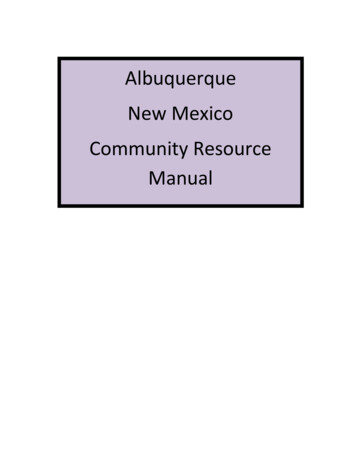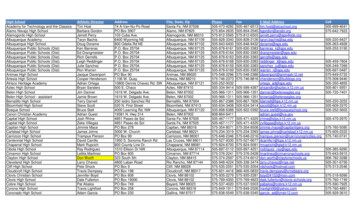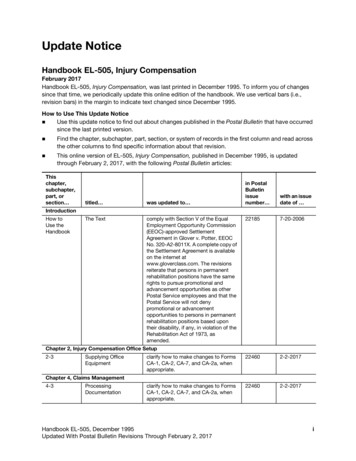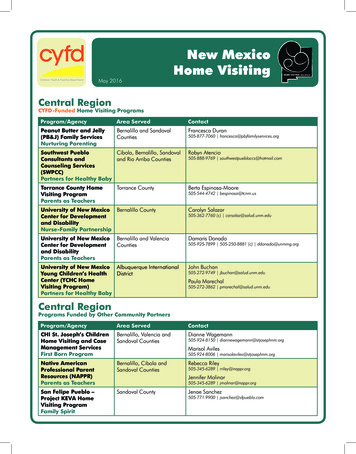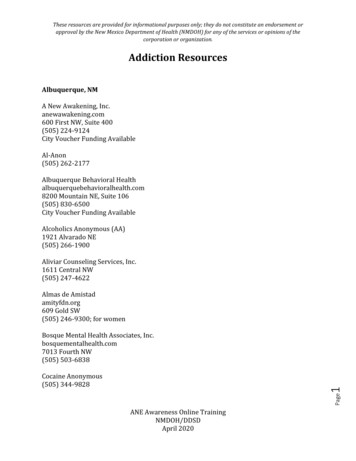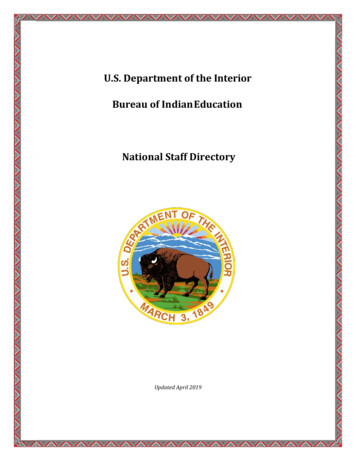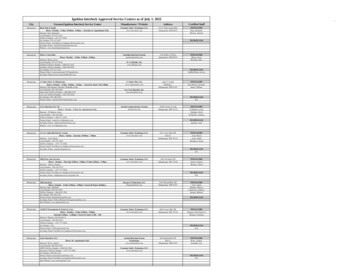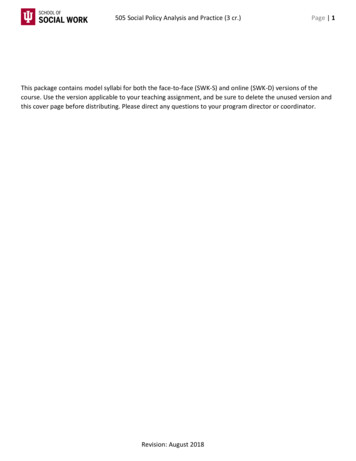
Transcription
505 Social Policy Analysis and Practice (3 cr.)Page 1This package contains model syllabi for both the face-to-face (SWK-S) and online (SWK-D) versions of thecourse. Use the version applicable to your teaching assignment, and be sure to delete the unused version andthis cover page before distributing. Please direct any questions to your program director or coordinator.Revision: August 2018
Page 2505 Social Policy Analysis and Practice (3 cr.)SWK-S 505 Social Policy Analysis and Practice (3 cr.)Course InformationSemester Year:Section Instructor:Office:Email:Phone:Office Hours:XXXXX XXXXXXXXXXXXXXXXXXXXXXXXXCourse DescriptionThis course examines the processes that influence the development of social policy and social services.Included are legislative and political processes, models of policy analysis, service delivery and policyimplementation. Effects of these on people are considered from global, political, economic, environmentaland social policy perspectives.This course is developed around the general proposition that social workers utilize knowledge and skills tocarry out roles and functions critical for practice. Such knowledge and skills include the application of socialpolicy analysis, the legislative process, the role and impact of politics and political choice on the quality of lifeof people, and the effect of economic-social policy decision and judicial actions on social services. In addition,the course examines the variability of the common and uncommon attributes of service delivery systems.Course CompetenciesCouncil on Social Work Education (CWSE) 2015 EPAS Competencies addressed by this course.Primary 5: Engage in Policy PracticeSocial workers understand that human rights and social justice, as well as social welfare and services,are mediated by policy and its implementation at the federal, state, and local levels. Social workersrecognize and understand the historical, social, cultural, economic, organizational, environmental, andglobal influences that affect social policy. Social workers are knowledgeable about policy formulationand analysis (CSWE, 2015 EPAS, p. 8).Secondary 1: Demonstrate Ethical and Professional Behavior3: Advance Human Rights and Social, Economic, and Environmental JusticeCourse Objectives1. Distinguish the common attributes of all service delivery systems, such as auspices,organizations, decision-making processes, need-demand factors and provider-consumerrelationships. Evaluate and apply research literature related to social work practice.Revision: August 2018
505 Social Policy Analysis and Practice (3 cr.)Page 32. Assess the impact of the variability of the common attributes of service delivery on socialservice systems. Demonstrate a beginning understanding of the uses and methods used insingle-system and program evaluation designs.3. Analyze the differential benefits of the major service delivery systems for people of color,women, gay and lesbian people, and other populations at risk and the factors related toinfluencing such differential benefits.4. Assess the dilemmas and trade-offs involved in the major issues related to service delivery, suchas integration, normalization and privatization.5. Assess the nature of power and control in the political and legislative process, the managementand control of information by lobbying forces and the positive and negative aspects of socialpolicy practice.6. Assess the impact of social and economic policies on the advancement or hindrance of socialand environmental justice and human rights.7. Evaluate relationships of social work values and ethics to service delivery, policy goals and thepolitical process.8. Assess and evaluate how the social constructions of problems relate to poverty, inequality,and systems of stratification, and apply analytic methods in advocating for special populationgroups, significant social issues and political or legislative goals.9. Evaluate the changing nature of individual, group, community and societal policy interdependency from a comparative global perspective.Required TextsHaynes, K. and Mickelson, J. (2010). Affecting change: Social workers in the political arena, (7th ed.). New York, NY: AllynBacon.Karger, H. and Stoesz, D. (2017). American social welfare policy: A pluralist approach (8th ed.). Boston, MA: Allyn Bacon.Course ContentThis course equips students to demonstrate ethical and professional behavior and to advance human rightsand social, economic, and environmental justice in and through policy practice.The major evaluation of students’ progress in accomplishing the learning objectives of this course is thesignature Policy Analysis Paper, which allows you to demonstrate your learning by utilizing social work valuesand ethics along with a social work policy analysis framework to analyze a bill and assess its potential impacton social, economic and/or environmental justice along with human rights, clarifying both a grounded socialwork position regarding the policy and then, in the name of that position, developing a strategy that could beused to build coalition, inclusive of civil society and the political realm, to move the position from paper toreality.Be mindful that academic and experiential content in social work courses may trigger an emotionalresponse, especially in individuals who have prior trauma history. As social workers, it is our responsibilityto be present for clients who have experienced trauma; therefore, it is necessary to cultivate compassionateself-awareness and address our personal histories in a timely manner for competent social work practice. Ifyou are triggered in the classroom, your priority is self-care as well as continuing to gain knowledge forRevision: August 2018
505 Social Policy Analysis and Practice (3 cr.)Page 4practice. You may need to seek consultation from faculty as to your readiness for practice and/or how tobetter prepare for social work practice.Resources Canvas email will also be used a way to communicate between instructor and students. You areexpected to check the course announcements on Canvas before each class.Additional readings will be assigned throughout the semester and be posted on Canvas (Resource tab).Course OutlineModule 1: Policy Analysis FrameworksDates:OverviewA.B.C.D.Introduction to the courseOverview of assignmentsTechnology as a resource to keep current on policy developmentHow to use policy analysis frameworksAssignmentsReadings1. Karger and Stoesz, Chapters 1 & 3 from required text.2. Browse advocacy links at http://www.socialworkers.org3. Browse iga.in.govModule 2: Policies to address povertyDates:OverviewA.B.C.D.Cash assistance: TANFFood assistance: SNAP and WICHousing assistance: HUDTheories of why poverty existsAssignmentsIndividual Assignment1. Social Work Speaks Position paper due 9/7Readings1. Karger and Stoesz, Chapters 5, 11, and 17 from required text for 9/7.2. Wilson, W.J. (2003). Race, class and urban poverty: A rejoinder. Ethnic and Racial Studies,26(6), 1096-1114 from Canvas for 9/14.3. Mead, L. (1989). The logic of workfare: The underclass and work policy. Annals of theAmerican Academy of Political and Social Science, 501(1), 156-169 from Canvas for 9/14.Module 3: Policies to address crimeDates:Revision: August 2018
505 Social Policy Analysis and Practice (3 cr.)Page 5OverviewA. The juvenile justice systemB. Competence to stand trialC. Theoretical underpinnings of criminal justice policyAssignmentsReadings1. Karger and Stoesz, Chapter 14 from required text.Module 4: Policies to address health careDates:OverviewA.B.C.D.Costs of health care in the USMedicaid, Medicare and CHIPAffordable Care ActRecent policy debatesAssignmentsReadings1. Karger and Stoesz, Chapter 12 (9/28) and Chapter 13 (10/5)Module 5: Where and how state policies are setDate:OverviewA. Field trip to the Indiana State HouseB. 200 West Washington St., IndianapolisField trip informationPlease dress in business or business casual attire.PLEASE GET THERE EARLY! YOU MUST GO THROUGH SECURITY!Public entry is available at the following building entrances: Upper leave east doors, closest to Capitol Ave. and Market St.Lower level, west doors, with access from Robert D. Orr Plaza (ADA accessible).Visitors will be required to pass through metal detectors, and all bags and packages willbe x-rayed and may be subject to further inspection.Assignments1. Agency Policy Paper due.Readings1. Hamilton, L. (n.d.). You need to understand lobbying. Available tand-lobbying;Revision: August 2018
505 Social Policy Analysis and Practice (3 cr.)Page 62. Carnick, L. (2008). Practicum II/III: Indiana State Legislature. Author. This is the final paperfrom a student who interned with the Indiana State Senate for her practicum (available onCanvas)3. Indiana State House History at Indiana Statehouse Tour Office website, including the links: A Center of Civic LifeIn Character with the ParthenonIn Clear ArrangementThe First One Hundred YearsRestoration at its BestA Solid FoundationModule 6: Policies to address child welfareDate:OverviewA.B.C.D.History of Child WelfareDevelopment of child abuse and neglect lawsWhat happens when DCS receives a callMedia coverage of DCSAssignmentsReadings1. Karger and Stoesz, Chapter 15.2. Kahan, M. (2006). “Put up” on platforms: A history of twentieth-century adoption policy inthe United States. Journal of Sociology and Social Welfare, 33(3), 51-72. (available onCanvas)Module 7: How a bill becomes a lawDate:OverviewA.B.C.D.Federal legislative processIndiana legislative processPACsLegislative decision makingAssignmentsReadings1. Hayes and Mickelson, Chapters 1, 2 and 5 from required text.Module 8: Lobbying and presenting testimonyDate:OverviewA. Working as a legislatorB. The electoral collegeRevision: August 2018
505 Social Policy Analysis and Practice (3 cr.)Page 7C. Devolution of legislationD. TestifyingAssignmentsReadings1. Hayes and Mickelson, Chapters 6, 7, 8 and 102. “How to give effective legislative testimony” Module 9: American voting systemDate:OverviewA.B.C.D.The two-party systemDirect DemocracyGerrymandering and vote dilutionCampaign financeAssignmentsReadings1. Karger and Stoesz, Chapters 2 and 4Module 10: Legislator profile presentationsDates:OverviewA. Please use class time November 16 to complete group presentationsB. Presentations given November 30Readings1. Haynes and Mickelson, Chapters 9, 11 and 12Module 11: Course wrap upDate:OverviewA. Signature assignment dueB. Course wrap up discussionAssignmentsA. Signature assignment due at the beginning of class on CanvasB. Professional Participation assignment due the day after classC. Peer Evaluations due the day after classAssignments and GradingMore specific instructions for each assignment will be posted on Canvas. Instructor also will discuss details oranswer any questions related to assignment during the class and office hours.Revision: August 2018
505 Social Policy Analysis and Practice (3 cr.)Page 8All assignments should be typed, double spaced, with one-inch margins on all sides, carefully edited andproofed, using no smaller than a 12 point font, and conforming to APA style (6th ed.)Assignments1. Social Work Speaks position paper (Group Assignment)a. DUE: .b. Final Grade Percentage: .10%2. Agency Policy Papera. DUE: .b. Final Grade Percentage: .20%3. Profile of a legislator presentation (Group Assignment)c. DUE: .d. Final Grade Percentage: .20%4. Signature assignment (Individual Assignment)a. DUE: .b. Final Grade Percentage: .30%5. Professional Participation (Individual Assignment)a. DUE: .b. Final Grade Percentage: .10%6. Peer Evaluations (Individual Assignment)a. DUE: .b. Final Grade Percentage: .10%Assignment DetailsSocial Work Speaks Position PaperIn the first part of this course we consider policies that impact issues pertinent to social workers andthe values they serve. The National Association of Social Workers (NASW) publishes a policy journal,Social Work Speaks, which provides frameworks from which to view these issues and values. For thisassignment, you will select a social issue of interest to you and read about it in Social Works Speaks.You will write a paper to include the following:Section One: Personal Opinion What is your personal opinion on the social issue?What led you to this opinion?Section Two: NASW’s Opinion What is NASW’s position and how does the organization justify this position?Section Three: Personal ReflectionRevision: August 2018
505 Social Policy Analysis and Practice (3 cr.) Page 9Whether you agreed with the NASW prior to the assignment or not, had reading theposition statement on the issue changed your way of thinking? How?If you have a conflict with one of NASW’s policy statements, how will you handle it in yourcareer as a social worker?Profile of a Legislator PresentationThe purpose of this assignment is to get to know some of the individuals who create the policies thatgovern Indiana, and to get a sense of how these individuals make decisions when voting on bills that couldhave extensive impact on our client base.Consider the following for your presentation:1.2.3.4.5.6.7.8.9.How did the person get into politics?What is his or her educational and career background?How long has the person been in office?Are they on any committees? If so, which ones?What is the typical process of how the person goes about deciding upon a bill? (Who do theyseek input from? How do they educate themselves regarding a bill? How do they measurepublic opinion?)How much influence does public opinion have upon their decisions?What has been one of the toughest bills they have had to vote upon?Please pay close attention to the Making Government Policy module for additional guidance onquestions and framing of the interview.Feel free to add additional information you obtain in your research and communication withthe legislator.Agency Policy PaperA large portion of this course focuses on advocating for policy changes to better the lives of the clientswe serve. This paper provides you the opportunity to connect social welfare policy with day-to-daypractice. First, you will select an organization that you have access to. You might consider usingcurrent/previous practicum placements, your place of employment, or other familiar social serviceagencies. Second, you will select a policy of the organization. Third, you will analyze the policy.Section One: Policy Description Describe the policy (e.g. what does the policy say, who does it impact, why is it in place).Section Two: Consequences of the Policy Research the intended and unintended consequences of the policy.Section Three: Strategic Planning Develop recommendations for changing the policy to better serve clientsCreate a strategic plan for implementing the changes you suggest.Policy Analysis Paper (Signature Assignment)After researching bills that are being or were considered within the last two legislative sessions byeither the Indiana General Assembly or the United States Congress, select one bill with clearimplications for social workers and/or the populations/issues we engage.Revision: August 2018
505 Social Policy Analysis and Practice (3 cr.)Page 10In this assignment, writing the paper as if the bill were currently up for consideration, you are toanalyze the bill according to the assigned policy analysis framework and then to determine, accordingto your analysis in light of the Code of Ethics and Social Work Speaks (NASW), whether to support thebill in full, make recommendations for changing portions or the bill, or to oppose the bill altogether.For State bills, go to Indiana General Assembly Archive. For Federal bills, go to Congress.gov LegislationSearch.The paper is broken into five distinct sections. Please use headings and subheadings to indicate yourtransitions from one section to another. Remember you should always include a paragraphintroduction and conclusion in your academic papers.Section One: General Information about the Bill Provide basic information about the bill (or law) you selected (e.g. title, assigned SB or HBnumber, current status, and the committee name or members that introduced the bill).Section Two: Selection Process Describe the reason you selected the bill (or law).Why is this legislation important to social workers and our clients?What are the essential social issues the bill intends to address?What is NASW’s position and how does the organization justify this position?Section Three: Policy Analysis Utilizing the provided model for policy analysis, examine the goals and potential implicationsfor this legislation:1. Describe the policy: For the description section of the paper, consider the following subheadings: Historical BackgroundProblem that Necessitated the PolicyPolicy Description2. Analyze the policy: For the analysis section of the paper, consider the following subheadings: Goals: Address legality justice and democracy, social equality, redistribution,quality of life, social relations, and social work values.Political FeasibilityEconomic FeasibilityAdministrative FeasibilitySection Four: Recommendations Address the following: Recommendation: Provide your position (support, opposition, or change), on the bill.Revision: August 2018
505 Social Policy Analysis and Practice (3 cr.) If any, what recommendations do you have regarding how this policy issue might bebetter addressed? How has the past shaped your recommendations for the future?Rationale: Page 11Ground your position in social work ethics and values, making sure to cite the Code ofEthics and Social Work Speaks (NASW).Strategy: Describe and justify the types of agencies and organizations that you think would besympathetic to your position along with possible candidates/legislators for coalitionbuilding. What alliances might be possible?What strategies would you deploy for getting people to “think outside the box”regarding this issue or problem?How do you recommend that you and other social workers advocate to address thepolicy issues you have identified? Give at least three (3) examples of how you as a socialworker can bring about change that will have a positive impact on this issue or problemin the future.Section Five (Appendix): One-page Brief Complete your paper by appending a one page brief that summarizes your position byproviding a two or three sentence paragraph that can be comfortably read in ten seconds, anda list of bulleted talking points if you were to provide testimony.Grading StandardsPapers are graded on the quality of the final product not on the effort you extended completing them.The grade of A is reserved for truly outstanding work that goes beyond basic requirements.In the Indiana University School of Social Work MSW program, grades of B are the expected norm.Reflecting competency and proficiency, grades of B reflect good or high quality work typical of graduatestudents in professional schools. Indeed, professors typically evaluate students’ work in such a way that Bis the average grade. Grades in both the A and the C range are relatively uncommon and reflect work thatis significantly superior to or significantly inferior, respectively, to the average, high quality, professionalwork conducted by most IU MSW students. Because of this approach to grading, students who routinelyearned A grades in their undergraduate studies may conclude that a B grade reflects a decrease in theiracademic performance. Such is not the case. Grades of B in the IU MSW program reflect the average,highly competent, proficient quality of our students. In a sense, a B grade in graduate school is analogousto an A grade in undergraduate studies. MSW students must work extremely hard to achieve a B grade. Ifyou are fortunate enough receive a B, prize it as evidence of the professional quality of your work.Grades of A reflect Excellence. Excellent scholarly products and academic or professional performancesare substantially superior to the “good,” “the high quality,” “the competent,” or the “satisfactory.” Theyare unusual, exceptional, and extraordinary. Criteria for assignments are not only met, they are exceededby a significant margin. Excellence is a rare phenomenon. As a result, relatively few MSW students earn Agrades.Revision: August 2018
505 Social Policy Analysis and Practice (3 cr.)Page 12Grades of B signify good or high quality scholarly products and academic or professional performance.Grades in the B range reflect work expected of a conscientious graduate student in a professionalprogram. Criteria for assignments are met in a competent, thoughtful, and professional manner. However,the criteria are not exceeded and the quality is not substantially superior to other good quality products orperformances. There is a clear distinction between the good and the excellent. We expect that most MSWstudents will earn grades in the B range—reflecting the good or high quality work expected of competentfuture helping professionals.Grades of C and C signify work that is marginal in nature. The scholarly products or professionalperformances meet many but not all of the expected criteria. The work approaches but does not quitemeet the standards of quality expected of a graduate student in a professional school. Satisfactory in manyrespects, its quality is not consistently so and cannot be considered of good or high quality. We anticipatethat a minority of MSW students will earn C and C grades.Grades of C- and lower reflect work that is unsatisfactory. The products or performances do not meetseveral, many, or most of the criteria. The work fails to approach the standards of quality expected of agraduate student and a future MSW-level professional. We anticipate that a small percentage of MSWstudents will earn unsatisfactory grades of C-, D, and F.Grading scaleGrade minimums are as follows [Note: grades below C are Unsatisfactory in the MSW Program]:A93%Excellent, Exceptional QualityA-90%Superior QualityB 87%Very Good, Slightly Higher QualityB83%Good, High Quality (expected of most MSW students)B-80%Satisfactory QualityC 77%Marginal, Modestly Acceptable QualityC73%Marginal, Minimally Acceptable QualityC-70%Unsatisfactory QualityRevision: August 2018
Page 13505 Social Policy Analysis and Practice (3 cr.)SWK-D505 Social Policy Analysis and Practice (3 cr.)Course InformationSemester Year:Section hone:Office Hours:Term and yearXXXXXXXXXXXXXXXXXXXXXXXXX XXXXXXXXXXXXXXXXXxxxxxxxxxxxxxxxCourse DescriptionThis course examines the processes that influence the development of social policy and social services.Included are the legislative and political processes, models of policy analysis, service delivery and policyimplementation. Effects of these on people are considered from global, political, economic, environmental,and social policy perspectives.This course is developed around the general proposition that social workers utilize knowledge and skills tocarry out roles and functions critical for practice. Such knowledge and skills include the application of socialpolicy analysis, the legislative process, the role and impact of politics and political choice on quality of life ofpeople, and the effect of economic-social policy decision and judicial actions on social services. In addition, thecourse examines the variability of the common and uncommon attributes of service delivery systems.Course CompetenciesCouncil on Social Work Education (CWSE) 2015 EPAS Competencies addressed by this course.Primary Competency 5: Engage in Policy PracticeSocial workers understand that human rights and social justice, as well as social welfare and services,are mediated by policy and its implementation at the federal, state, and local levels. Social workersrecognize and understand the historical, social, cultural, economic, organizational, environmental, andglobal influences that affect social policy. Social workers are knowledgeable about policy formulationand analysis (CSWE, 2015, EPAS, p. 8).Secondary Competency 1: Demonstrate Ethical and Professional Behavior Competency 3: Advance Human Rights and Social, Economic, and Environmental JusticeCourse Objectives1. Distinguish the common attributes of all service delivery systems, such as auspices,organizations, decision-making processes, need-demand factors and provider-consumerrelationships. Evaluate and apply research literature related to social work practice.Revision: August 2018
505 Social Policy Analysis and Practice (3 cr.)Page 142. Assess the impact of the variability of the common attributes of service delivery on socialservice systems. Demonstrate a beginning understanding of the uses and methods used insingle-system and program evaluation designs.3. Analyze the differential benefits of the major service delivery system for people of color,women, gay and lesbian people, and other populations at risk and the factors related to servicedelivery, such as integration, normalization, and privatization.4. Assess the dilemmas and trade-offs involved in the major issues related to service delivery, suchas integration, normalization, and privatization.5. Assess the nature of power and control in the political and legislative process, the managementand control of information by lobbying forces, and the positive and negative aspects of socialpolicy practice.6. Assess the impact of social and economic policies on the advancement or hindrance of socialand environmental justice and human rights.7. Evaluate relationships of social work values and ethics to service delivery, policy goals, and thepolitical process.8. Assess and evaluate how the social constructions of problems relate to poverty, inequality, andsystems of stratification, and apply analytic methods in advocating for special populationgroups, significant social issues, and political or legislative goals.9. Evaluate the changing nature of individual, group, community, and societal policyinterdependency from a comparative global perspective.Required Texts Karger, H., & Stoesz, D. (2014). American social welfare policy: A pluralist approach (8th ed.). New York,NY: Pearson.Course ContentBe mindful that academic and experiential content in social work courses may trigger an emotional response,especially in individuals who have prior trauma history. As social workers, it is our responsibility to be presentfor clients who have experienced trauma; therefore, it is necessary to cultivate compassionate self-awarenessand address our personal histories in a timely manner for competent social work practice. If you are triggeredin the classroom, your priority is self-care as well as continuing to gain knowledge for practice. You may needto seek consultation from faculty as to your readiness for practice and/or how to better prepare for socialwork practice.This course equips students to demonstrate ethical and professional behavior and to advance human rightsand social, economic, and environmental justice in and through policy practice.The major evaluation of students’ progress in accomplishing the learning objectives of this course is thesignature Policy Analysis Paper, which allows you to demonstrate your learning by utilizing social work valuesand ethics along with a social work policy analysis framework to analyze a bill and assess its potential impacton social, economic and/or environmental justice along with human rights, clarifying both a grounded socialwork position regarding the policy and then, in the name of that position, developing a strategy that could beRevision: August 2018
505 Social Policy Analysis and Practice (3 cr.)Page 15used to build coalition, inclusive of civil society and the political realm, to move the position from paper toreality.Resources Canvas email will also be used a way to communicate between instructor and students. You areexpected to check the course announcements on Canvas before each class. Additional readings will be assigned throughout the semester and be posted on Canvas (Resource tab).Course OutlineModule 1: Models for Policy Analysis: Understanding Social and Economic JusticeWeek 1OverviewThis module explores a number of theories within the context of “political economics” to analyzesocial welfare policy.AssignmentsReadings1) Karger, H., & Stoesz, D. (2014), Chapters 1, 2, 9, and 18 from required text.2) National Association of Social Workers. (2012). Social work speaks: NASW policystatements, 2012-2014 (9th ed.). Washington, DC: NASW Press. Forward, InternationalPolicy on Human Rights, and Peace and Social Justice (Canvas).Group Assignment3) Group Discussion: Upward MobilityIndividual Assignments4) Quick Check Activity: Institutional Welfare Review5) Individual Application: The Crime of Unauthorized ReproductionModule 2: Understanding the Auspice of Social WelfareWeek 2OverviewThis module discusses the major historical trends that have shaped religion in the United Statesand how religion has influenced the development of social welfare policy.AssignmentsReadings1) Karger, H., & Stoesz, D. (2014), Chapters 2, 6, and 7 from required text.Group Assignment2) Group Discussion: “K” StreetRevision: August 2018
505 Social Policy Analysis and Practice (3 cr.)Page 16Individual Assignment3) M2 QuizModule 3: Poverty & Public Assistance ProgramsWeek 3OverviewThis module looks at different definitions and identifies “Who are the poor?”. It also examinestrends in poverty, theories as to why poverty exists, and public assistance programs.AssignmentsReadings4) Karger, H., & Stoesz, D. (2014)
This package contains model syllabi for both the face-to-face (SWK-S) and online (SWK-D) versions of the course. Use the version applicable to your teaching assignment, and be sure to delete the unused version and this cover page before distributing. Please direct any questions to your program director or coordinator.
